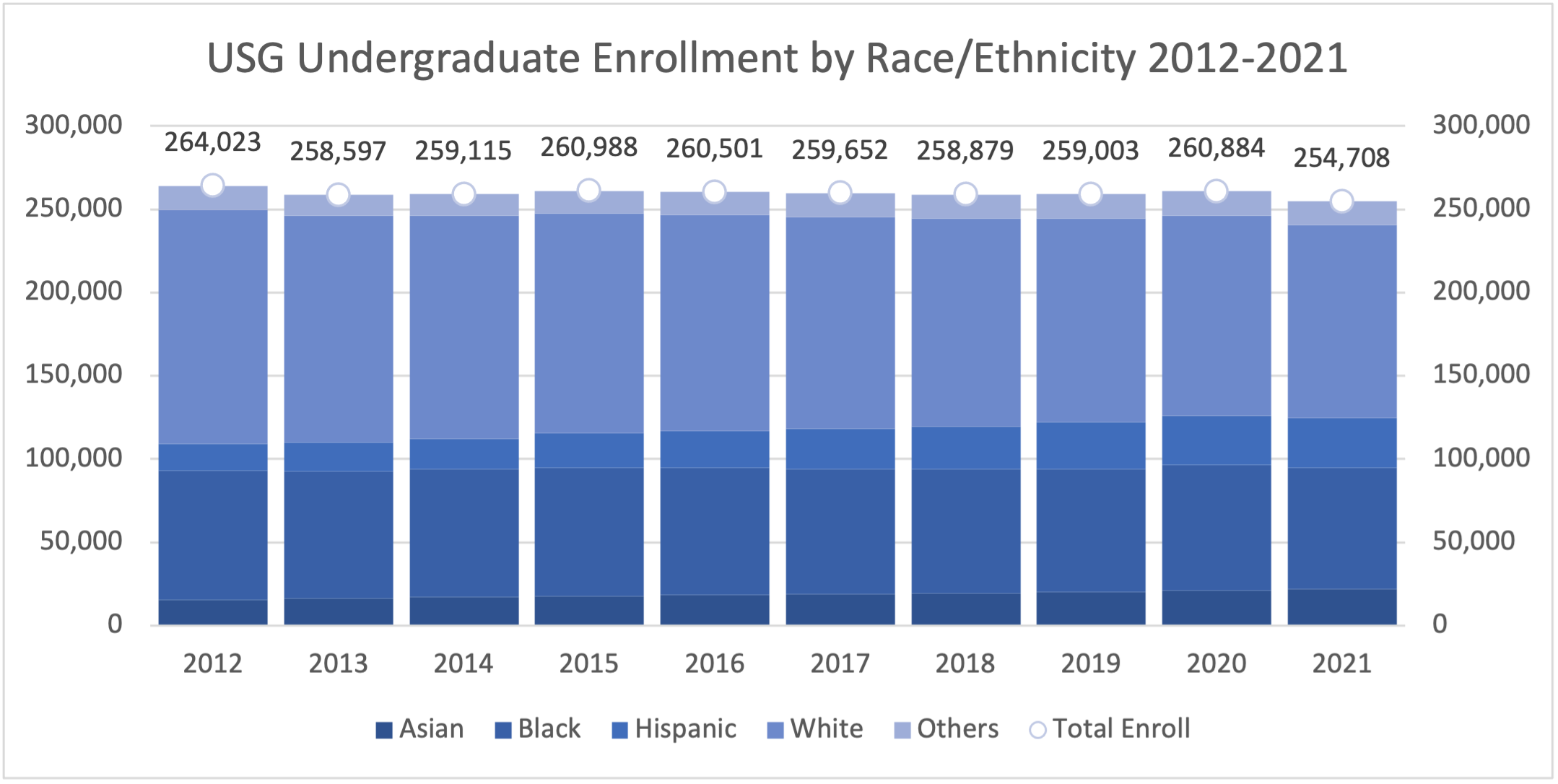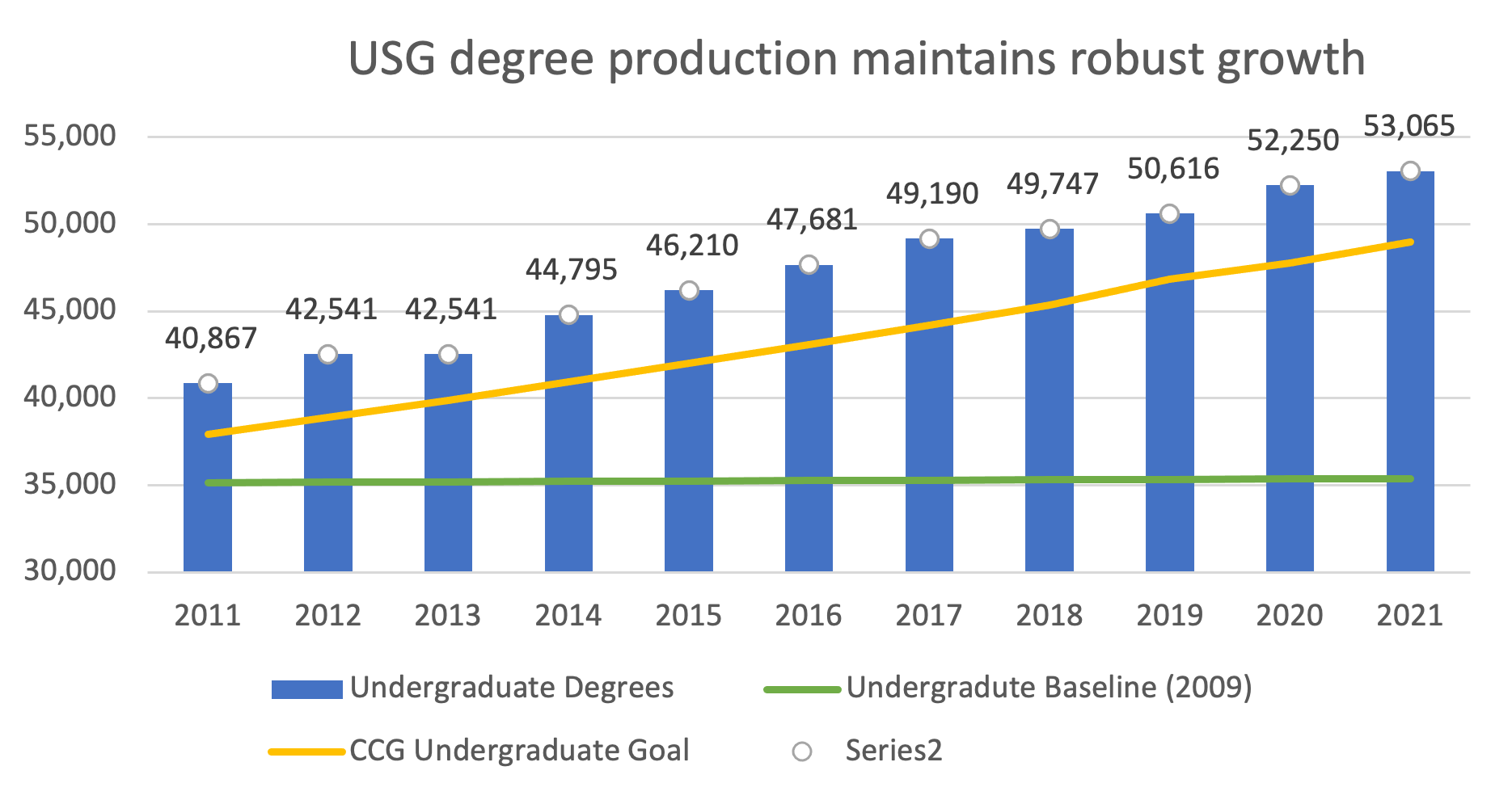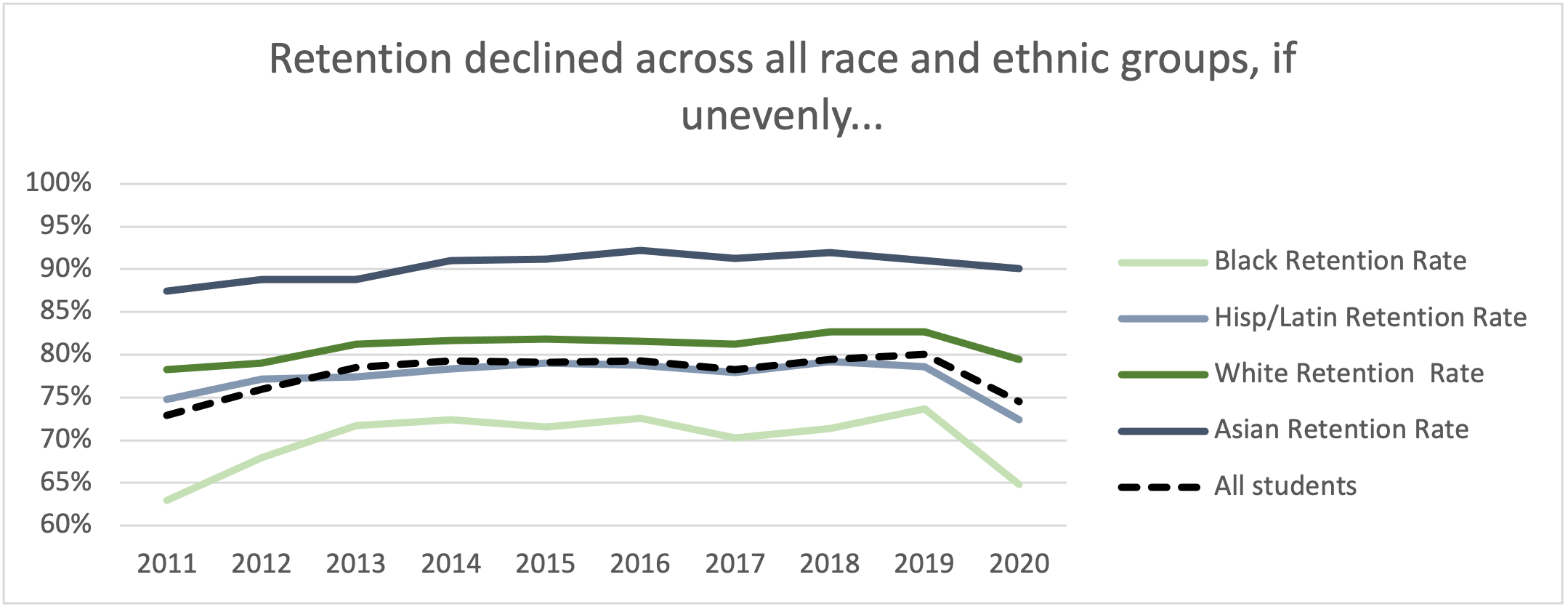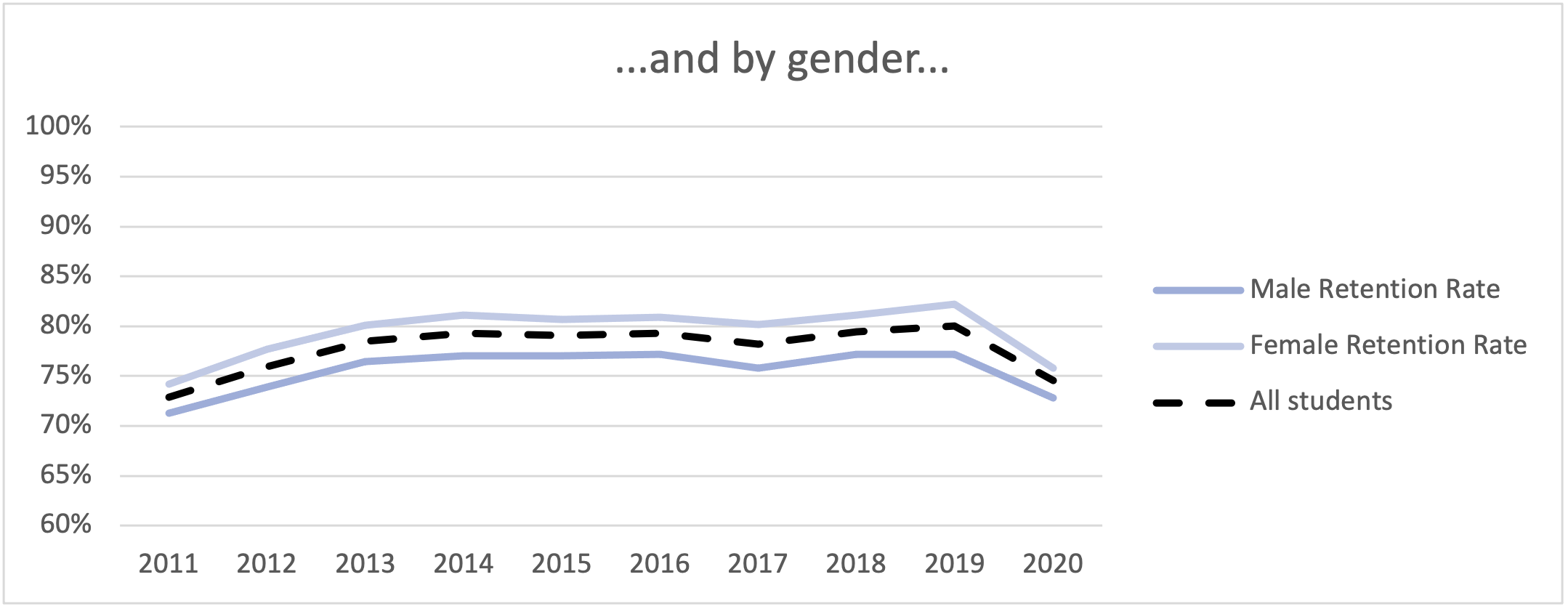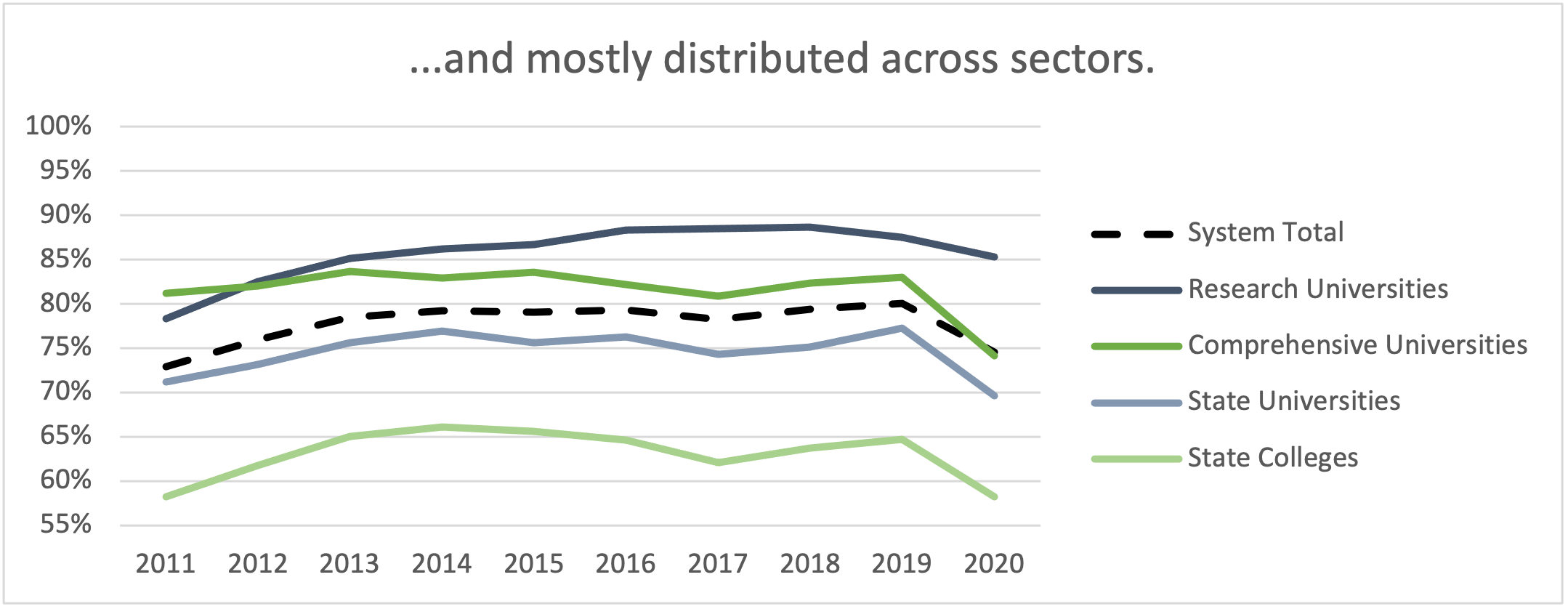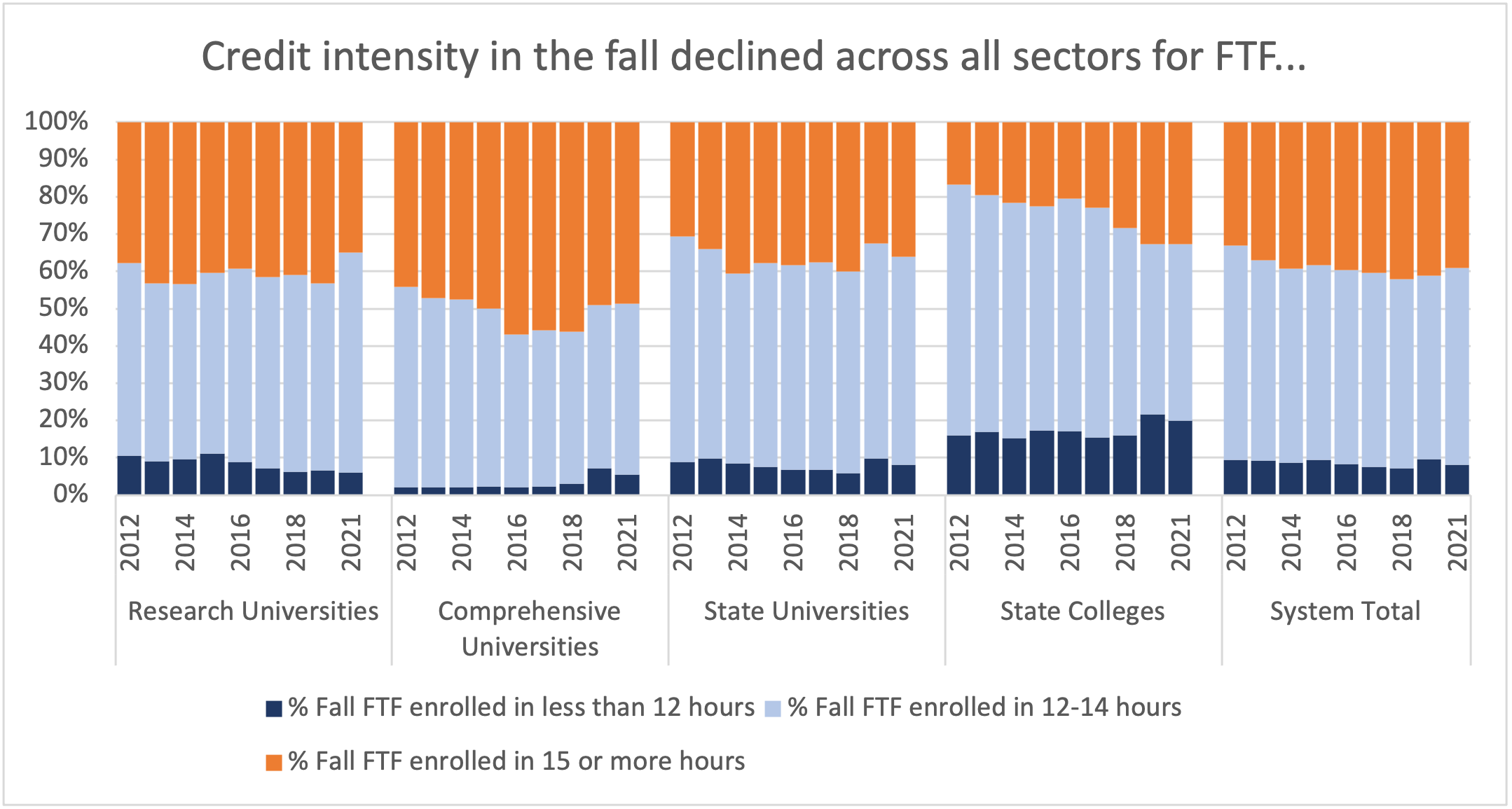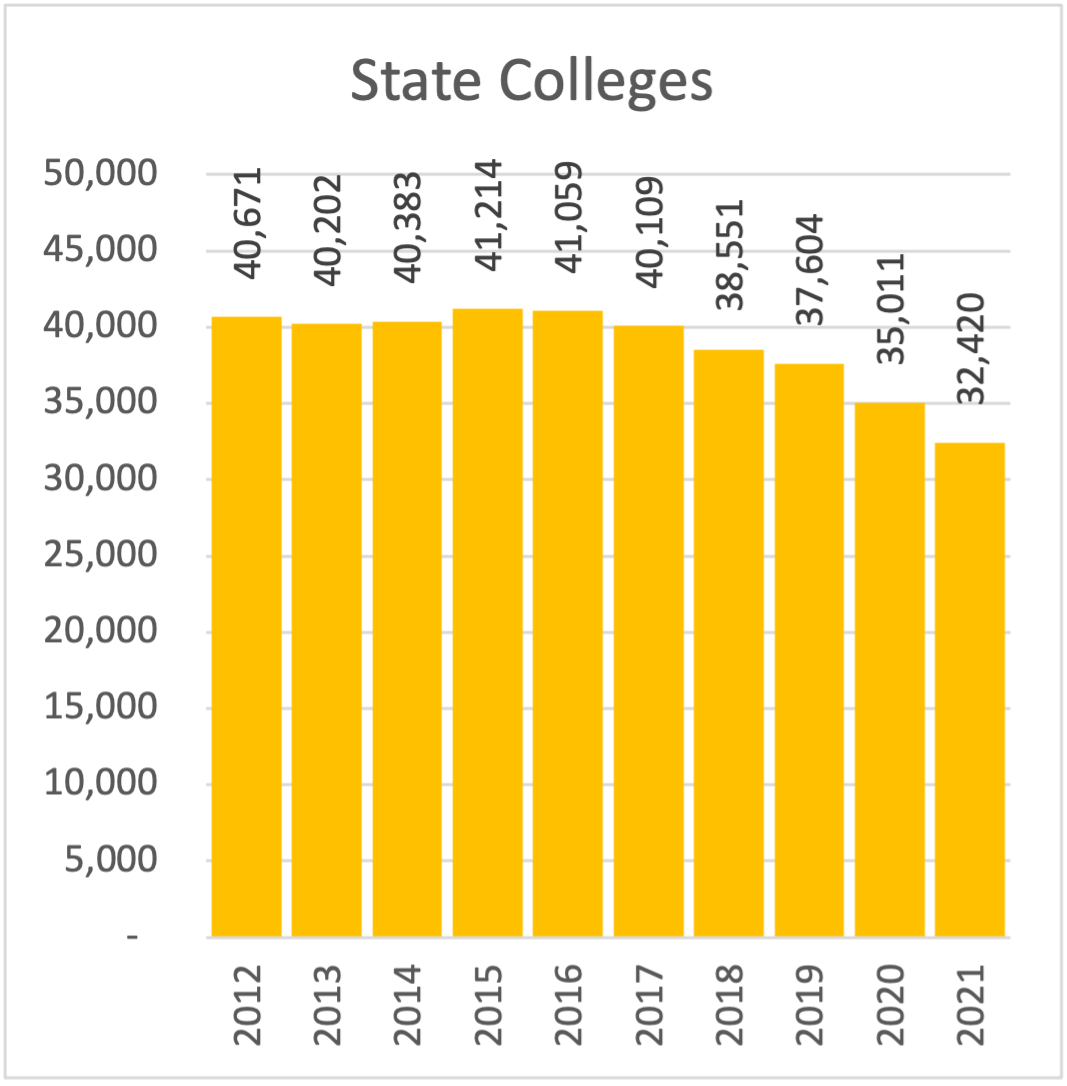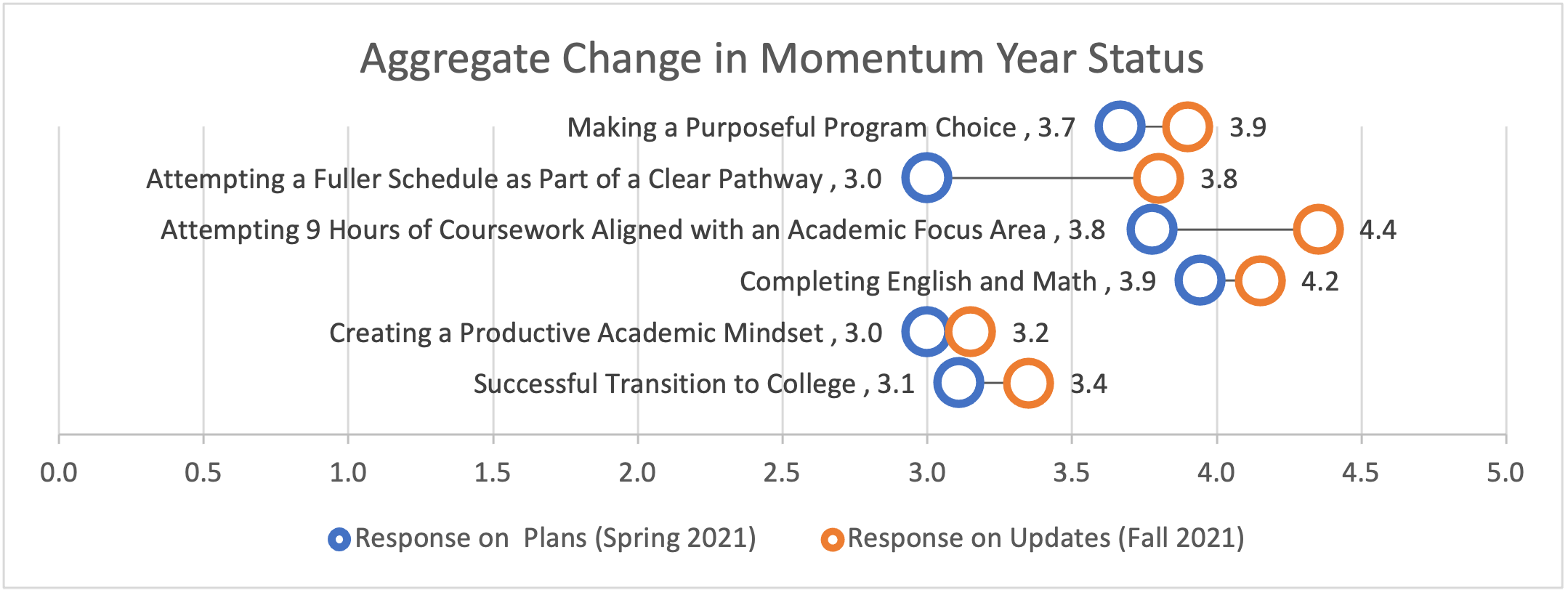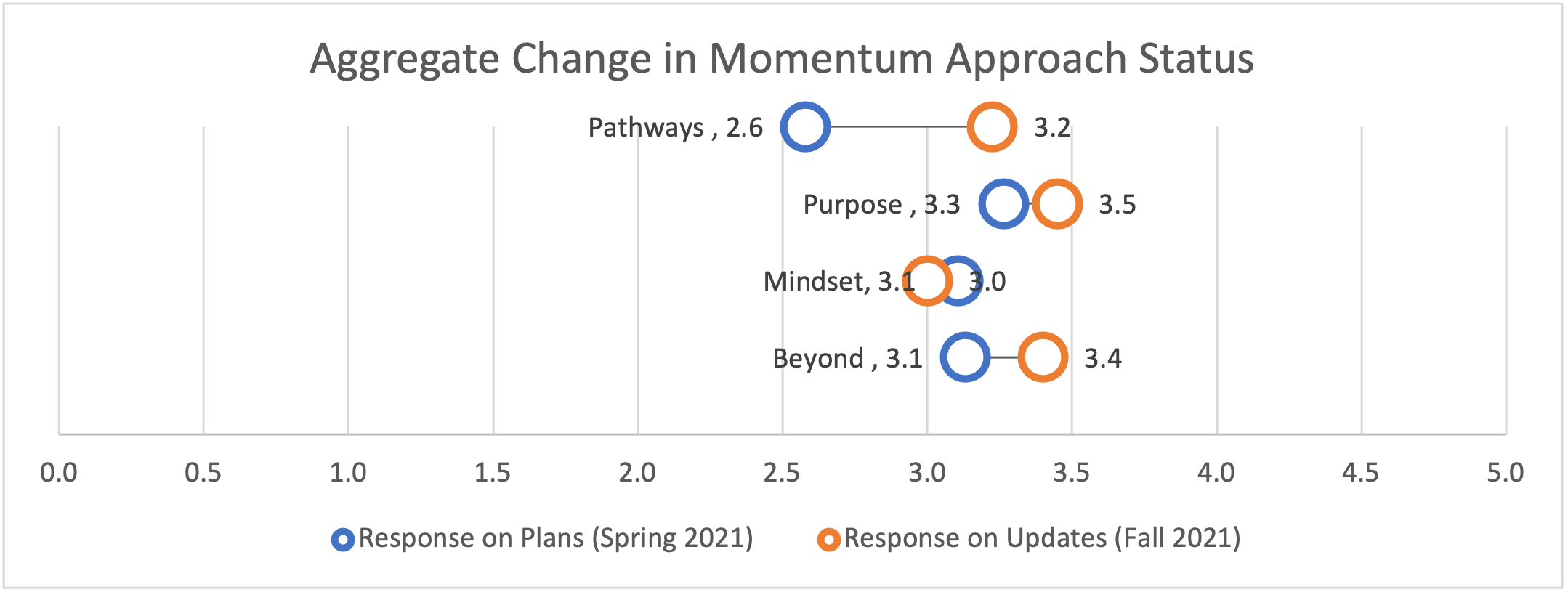University System of Georgia Campus Plan Update 2021
SYSTEM OVERVIEW
Established in 2011, Complete College Georgia (CCG)was conceived as a collaborative effort among Georgia’s K-12 schools, public colleges, universities and technical colleges, and the private sector to take concrete steps to improve college access and completion in the state. Framed on a set of high impact, evidence-based strategies, CCG builds on national research and local activities to support student success at all levels. The overarching goal is to graduate an additional 250,000 Georgia students with high-quality degrees or certificates by 2025 in order to reach projections of employment readiness. Each institution in the University System of Georgia have submitted and updated action plans on their activities that have the greatest impact on college completion within their institutional mission and context.
For the University System of Georgia, CCG has evolved into a framework for focusing institutional attention on what matters most: helping Georgia’s students succeed. Institutions have adopted, adapted, and promoted a wide range of strategies to suit their local settings. More importantly, the work of promoting student success has become broadly shared on campus and better understood across the units of institutions. As the work of CCG has evolved to incorporate a Momentum Approach to student success, institutions have adapted more holistic approaches to improving student outcomes and addressing persistent equity gaps. CCG continues to forge partnerships among functional areas and foster understandings of how the various elements of a college or university come together. These partnerships have created statewide support for Georgia’s orientation in building a 21st century workforce.
SYSTEM PROFILE
The University System of Georgia (USG) includes 26 institutions, with fall 2021undergraduate enrollment of 254,708 students. Academic year 2021 marked the first year that enrollment in the University System has declined following a six-year period of regular increase. Fall 2021 undergraduate enrollment declined by 6,176 students, or roughly 2.1 percent, over fall 2020. The decrease in enrollment at USG institutions is comparable to national trends, with four-year public institutions nationally experiencing a slight (2.3 percent) drop in enrollment in the past year.
The University System’s undergraduate enrollment in fall 2021 ranged from 1,554 at Atlanta Metropolitan State College to 43,790 at Georgia State University. Georgia Tech witnessed the greatest percentage increase in enrollment since 2021 at 5.1 percent, followed by the Kennesaw State University at 4.3 percent and the University of Georgia at 1.1 percent. East Georgia State College saw the greatest decline in enrollment since 2020, dropping 16.5 percent, followed by South Georgia State College, which shrank by roughly 12.3 percent and Valdosta State University, which saw a decline of 8.5 percent in undergraduate enrollment (although 2020 enrollment at VSU was up 11.8 percent from 2019, so the institution remains above its 2019 enrollment).
The USG serves a diverse undergraduate population: White students comprise 45 percent of the total undergraduate enrollment, with Black or African American students representing nearly 29 percent, Hispanic students nearly 12 percent, and Asian students nearly 9 percent. Over the past five years, the number of Hispanic students has increased by 36 percent and the percentage of Asian students has increased by 18 percent. White enrollment has declined by 9 percent and Black or African American enrollment and white enrollment has declined by 2 percent over this same period. Figure 1 illustrates the shifting composition of students enrolled in USG institutions.
Complete College Georgia launched in 2011 with a commitment to increase the educational attainment of Georgians and a specific goal of increasing the percentage of young adults aged 25-34 with a credential of economic value from 40 percent to 60 percent by 2025. Undergraduate degree conferrals in the University System have risen nearly 30 percent since 2011 (from 40,867 to 53,065), remaining above the goals established for CCG by nearly 10 percent over this period. The figure below illustrates this trend.
Over the past year, the 26 institutions from across the University System have broadened and extended the kinds of supports to students to ensure their success. Among the lessons from the Pandemic have been an understanding of how to deliver high quality support to students in all modalities and the essential value of providing as much authentic connection to our campuses as possible. We have also learned valuable lessons about delivering quality professional development at scale for faculty and staff that will have significant benefits for students in the years to come. Possibly the most significant lesson has been the ways in which campuses have been able to adapt existing structures and staff to meet new challenges, and the strains that these adaptations have placed on both individuals and the projects that they are engaged in.
To support this, the System Office has provided opportunities to extend engagement to a broader group of stakeholders on campuses and provided more intentional ongoing engagement with institutional leadership to understand their contexts, challenges, and innovative work. The broader adoption of virtual platforms has greatly extended the opportunities for collaboration and engagement between faculty and institutional staff, which has provided an ability to reach a much broader audience for Momentum activities and ensure that the core features of the approach are understood by an ever-expanding audience.
Impact of the Pandemic
It is unsurprising that the Covid-19 Pandemic led to significant changes at and for USG institutions and their students. Unsurprisingly, among the largest changes was the rapid adoption of new technology to support the delivery of classes, support services, and business processes. The sudden shift to virtual instruction in spring 2020 exposed a number of gaps in the ability of students to access materials online and the readiness of faculty and staff to support students who were entirely remote. In short order, however, institutions implemented technology loan programs, trained faculty and staff, and created resources to support and engage students in online settings.
As the System returned to more face-to-face instruction, the lessons, opportunities and expectations around digital delivery provided a profound shift in the way institutions operate. A few key examples include an increased reliance on the Learning Management System (LMS) as the space where course materials, assessment, and communication reside (and a concomitant commitment to improving the quality and completeness of the material and tools deployed in the LMS); an explosion of access to services for students online, including tutoring, advising, counseling, and telehealth, allowing students to receive the supports they needed when and where they needed it; and a marked increase in the interest among faculty for professional development, both aligned with digital delivery but also to more generalized pedagogical innovations.
For all of this, there was also substantial negative consequences from the Pandemic. Most notably are declines in retention and credit intensity, along with a very recent drop in enrollment. Freshmen in the 2019 cohort, who the pandemic interrupted their spring semester of their first year, actually retained at slightly higher rates than previous cohorts, a testament to the tremendous outreach campus teams did at the start of emergency virtual instruction. The 2020 cohort, whose first year was often marked by blended and hybrid course delivery and less face-to-face experience on camps, witnessed a significant (~5.5 percentage point) drop in retention from 2020, to a level not experienced since the beginning of the Complete College Georgia project. The decline in retention was most pronounced among Black or African American students (-8.8 percentage points) and Hispanic students (-6.2 pp). Female students also declined at a slightly higher rate than male students, although their overall retention rate still was higher. The drop was largest at the Comprehensive University sector (-8.9 pp), although both State Universities and State Colleges saw decreases above the System average (-7.6 pp and -6.5 pp respectively). The figures below provide details over time.
Equally concerning, credit intensity, a metric that had been on the increase since the beginning of the CCG project, declined slightly in fall 2020, and then more precipitously in fall 2021 for both first time freshmen and all undergraduates. While small declines were inevitable in 2020 due to reduced classroom capacity as well as student modal preferences, the acceleration of this trend in 2021 indicates a more troubling challenge for institutions. Reductions in credit-taking by students is observed in several campus updates, with reasons as varied as student exhaustion, financial concerns or constraints, frustration with virtual instruction (and, paradoxically, frustration with a lack of online course options), increased wages and economic opportunities available, and increased family and caretaking demands.
The consequences of a reduction in credits are multiple, including longer paths to completion for students, with more opportunities for exit, increased possibilities for students to get off track in their program because course sequences and pathways are generally designed based on 15 credit hour terms, which will complicate course offering plans for institutions, and decreased revenues at institutions. Moreover, analysis from within the University System and beyond indicates increased outcomes overall for students taking fuller schedules, so the drops in credit intensity may also signal future academic challenges as students advance in their programs
Finally, the University System was among the few states where undergraduate enrollment increased in 2020, but dipped in fall 2021 to a level not seen since prior to the beginning of Complete College Georgia. Overall, undergraduate enrollment declined by 2 percentage points (6,176 students). Black and White undergraduate enrollment declined by 4 percentage points each, while Asian and Hispanic enrollment increased by 5 and 2 percentage points respectively. The drop in enrollment has not been evenly distributed across sectors. Changes in admissions requirements because of the Pandemic, most notably the elimination of college entrance examinations as a consideration due to the inability of students to take them, shifted enrollment from state colleges to other institutions, so while overall system undergraduate fall enrollment increased by just under 1 percentage point in 2020 from 2019, state college fall enrollment shrank by nearly 7 percent in 2020 (most of the gains in 2020 were in the comprehensive sector, which grew by 5.7 percent). In 2021 enrollment declined overall (by 2.4 percent), with state colleges again absorbing the bulk of the drop (an additional 7.4 percent), followed by state universities, which shrank by nearly 5 percent.
The figures below illustrate these changes.
Enrollment Trends by Sector
IMPROVEMENT PRACTICES
The University System has supported implementation of the Momentum framework on institutions through a process of structured planning, ongoing engagement, and regular updates. Key among this is the CCG/Momentum Plans, which are crafted by institutions through a process of internal structured planning around the Momentum Summit, submitted to the System Office, and form the basis for review, feedback, and connections across institutions. The formal planning process asks institutions to engage a broad cross-section of their community to identify priority opportunities and advance the direction of work at the local level.
The Momentum Summit IV, held virtually over two weeks in February 2021, provided an opportunity for 900 faculty, staff, and administrators to engage with state and national experts in more than 20 substantive sessions as well as formal time for team planning on campus. The broader reach of the Summit helped to broaden the reach of campus Momentum work to more faculty and staff who regularly engage with students. This shift in the conversation has helped to propel a deeper understanding of Momentum across the System, while highlighting areas where more work is necessary to contextualize or implement strategies that support student success.
The Momentum Summit IV focused on two key questions: Resilience of the work in the face of the Pandemic – both how to remediate any negative impacts from the Pandemic and how to make the most of the powerful lessons learned – and establishing a “global” approach to student success that integrates all aspects of the campus. The Summit was also a key point for sharing effective strategies from across the system, a key element of our change management approach.
The System Office also piloted the use of a “flipped” event with the Advising Academy in fall 2021, which featured materials and pre-recorded presentations in a course shell inside the collaborative USGTrain Brightspace D2L learning management system, with a live event set aside for discussions of the topics featured and for an exploration of a human centered design process to help emerge critical challenges. The event provided a further opportunity to expand the number of voices and perspectives on the program and in the conversation. By design, the discussions were integrative in nature, including admissions and enrollment management, registrars, advising, faculty, and student success support staff.
A final key element in our improvement practices has been the continuation of regular and formal check ins with academic affairs leadership on their work. Initially begun in response to the Pandemic as a check in on available resources, campus course offerings and modality, these team conversations have provided a semi-regular opportunity to gather and share solutions between institutions and to gain better insight into emerging challenges. This approach was employed for the feedback on 2021 Momentum Plans, providing a richer understanding of campus work, an opportunity to help connect institutions with resources available from the System or other institutions, and discover areas where support is still needed.
BIG IDEA: SCALABLE ENGAGEMENT
A challenge that many institutions met head on during the Pandemic was the need to provide essential skills training to faculty to teach online and to staff to move their work to a virtual environment. For just over a year, the System Office has been exploring scalable professional development for faculty and staff, beginning with “Starting Strong,” an online course to help faculty apply academic Mindset principles to the start of the semester delivered in the collaborative USGTrain environment. More than 500 faculty and staff signed up for either the asynchronous mini course or short course. This work supported the development of specific training materials to support the deployment of a Growth Mindset intervention in math courses (the Mindset Learning Project, originally deployed exclusively through eCore but extended to faculty at select institutions for deployment in in person settings in the past year), establishing an action-oriented training approach that supports faculty in making specific changes to their course or practice, provides the evaluation tool to assess the effectiveness of the training and the practice change, and a venue for sharing experiences with similarly engaged colleagues
Building upon this work and the existing structure for the Chancellor’s Learning Scholars, who lead two-year long Faculty Learning Communities, the University System has developed a professional training platform for faculty and staff, MomentumU@USG, that provides access to high-quality essential professional development on key student success pedagogies. Currently being tested by faculty and staff from across the system, the MomentumU platform will include badging and certificates for faculty completing courses and activities, opportunities for community building and engagement across institutions, and eventually a repository of resources for sharing. As this platform matures, the content and community components will provide opportunities to engage in robust exploration and discovery of improved teaching practice regardless of their institutional setting.
MOMENTUM WORK RESILIENCE UPDATE
Statistics Pathway & DATA 1501
Institutions were invited to begin offering Elementary Statistics as a recommended first math course to students whose academic programs were statistically based in 2019. Among the expectations of institutions opting into the Statistics Pathway was engagement with departments to update Gateway math recommendations, development of corequisite learning support for statistics for students requiring it, and consideration of changes adjustments to the Natural Sciences, Mathematics, and Technology area (Area D) of the general education curriculum to ensure that students taking statistics as a first math course had appropriate options to pursue.
This final element – the need for more options for students in Area D – led to the development of a collaboratively developed Introduction to Data Science (DATA 1501) that is designed to satisfy area learning outcomes at most institutions and be suitable for students across a range of disciplines without any prerequisite. The process of developing the course and the subsequent creation of a new, streamlined process of approval for similarly developed (or structured) courses provide a new avenue for leveraging the strengths of the System to innovate curricula and student learning. While both the statistics pathway and DATA 1501 are in their early stages, anecdotal reports point to high degrees of student engagement and a growing appreciation for the opportunities that exist for programs and students.
High Impact Practices
Plans for USG High Impact Practices (HIPs) Implementation at Scale continue in Fall 2021, building upon efforts begun with the 2018 Equity HIPs project and expanding to all 26 institutions with the HIPs Implementation Faculty initiative. This Implementation group of faculty leaders, 111 total, 4+ for each institution, was chosen by provosts to lead their institutions in scaling efforts. In Spring 2021, these faculty completed a series of USG training workshops on definition, development, certification, and implementation of HIPs, and provided early plans to supplement their institution’s Momentum Updates.
In Fall 2021, the second cadre of HIPs Implementation Faculty (totaling 110) moved these plans further along, preparing for the implementation of HIPs Certification via the MomentumU@USG and future use of the USG Course Attribute Dashboard. All 110 faculty have received Bronze certification in HIPs via MomentumU@USG, and a growing number are working toward Silver certification. Each team has also made plans for Spring 2022 implementation for consistent and efficient reporting of HIPs attributes in the BANNER Student Information System, with proposed steps to move toward use of the upcoming Course Attribute Dashboard.
Overall, USG transformation at scale to ensure HIPs/Experiential Learning includes a spectrum of efforts:
QUALITY ASSURANCE → COURSE DESIGN → COURSE DELIVERY → STUDENT EXPIERIENCE → DATA REPORT → ASSESSMENT
Academic Mindset
The shift to remote instruction in Spring 2020 and the continued uncertainty of the 2020-2021 academic year underscored the urgency of creating contexts on campus to support academic mindset. In summer 2020 as a component of the Keep Teaching and Keep Learning USG websites supporting faculty and students respectively, the System Office in partnership with Motivate Lab at the University of Virginia developed a suite of resources to support student expectancy (“Can I do this?”). These resources were designed to provide faculty with concrete tools to engage and support their students regardless of their modality, but especially in online settings.
Additionally, beginning in Fall 2020, faculty from across the System were invited to participate in a professional development course offered in the USGTrain D2L environment on motivating learners in their course by making a strong start. The mostly asynchronous course was offered in three sessions over the year, with more than 300 faculty and staff participating. Also in the past year a discrete growth mindset intervention that had been implemented in eCore across gateway math courses was piloted by faculty for use in face-to-face settings and additional supportive training was established to accompany deployment to ensure that the educational context reflected the messaging in the activities students engaged with.
At the institution level a remarkable degree of exploration of mindset is underway as well, with student and faculty resources around growth mindset, intentional practices to support a sense of belonging among students. As can be found in a number of the campus plan updates included here, institutions are embedding information about mindset in their first year courses to help students get off to a strong start, and working with faculty through ongoing faculty development, orientations and workshops to share resources and practices that support student mindset.
Credit Intensity and Program Maps
A significant concern emerging from the Pandemic is a decline in students taking on-time course loads. As noted in figure X, the overall share of students in Fall 2020 attempting 15 or more credits declined slightly from previous years, a trend that is anticipated to grow for Fall 2021 (Fall 2021 Full Time Equivalent students declined more markedly than did Headcount enrollment, pointing to a more rapid drop in student credit taking than in enrollment). It remains unclear the causes of this decline, although course availability, modality, increased uncertainty, improved economic options leading to students working more, and student hesitancy over fuller schedules may all play a factor.
Because of the established link between credit intensity and completion, this trend is especially worrying. Institutions have had limited success with marketing and information campaigns to increase student credit taking, indicating an upper limit on the effectiveness of communications strategies to impact student course-taking behavior. At institutions where communications strategies are complemented with default option is for a fuller schedules, the overall credit intensity is higher. For this reason, the System’s focus on credit intensity has been on creating smart defaults and architected choices for students.
Emerging from discussions of credit intensity and the previously described statistics pathways activity has been a renewed focus on the importance of Academic Program Maps to guide student choices. To better understand current practices, the System Office conducted outreach and focus groups with advisors and faculty. The outcome of these conversations Fundamental Features of Program Maps, a guidance document on the development, structure, maintenance and use of program maps to support student program selection and course-taking.
Academic Mindset
Over the past year and a half, activity across the System on Academic Mindset have shifted from a focus on understanding student mindsets to applying what has been learned to scalable activities to support constructive mindsets among students, and supportive contexts for mindset on campus. Evidence can be seen in many of the campus updates in this report, with a clear focus on developing mindset through targeted programming early in the transition to college and through the first year, as well as ongoing campaigns to build mindset through improved communication and engagement with students.
Additionally, recognizing that there is a vast amount of activity underway at institutions in the area, the System’s most recent convening on Academic Mindset focused on institutional activities and experiences. This is a significant departure from the previous model of training that was oriented around outlining and framing the concepts around mindset, specifically growth, purpose and sense of belonging (the GPS Mindsets) and reflects the degree of maturity this work has achieved in Georgia.
Finally, after demonstrating the effectiveness of a discreet Growth Mindset intervention delivered through eCore, the University System supported the deployment of a version of these student facing activities for delivery in face-to-face settings. These discrete interventions, modeled on the seminal “brain is a muscle” research, were surrounded with newly developed training for faculty to help them understand the concepts at play and how to create a context in their classes that support and amplifies the messages in the activities students encounter.
Adult Learners
The Discover Your GOAL Adult Learner Open House events are designed to provide real-time information to USG stop-out and drop-out adult learners who are interested in returning to college. In 2021, USG’s Adult Learning Consortium in partnership with the USG eCampus division hosted four Open House sessions (alternating between lunch time and early evening) to discuss and answer questions on pertinent re-entry basics on admissions, financial aid, completing the FAFSA, along with various online and face-to-face options. Each Open House highlighted one or more campuses and included adult learner testimonials. Nearly every participating institution also waived their application fees for those adult learners who submitted an application within a week of the event.
Over 200 potential adult learners signed up to participate in these virtual events. Each Open House was also featured as a Facebook Live event on the USG eCampus Facebook page. The Facebook Live event helped us to reach more adult learners who could not join us in our live Zoom session, by being available to be viewed at a later date and time.
The Adult Learning Consortium is a group of 21 USG campuses that have all signed an agreement to work together to identify and present best practices to the participating institutions regarding policies, programs, practices, and services to increase college completion by adult learners, including the subgroup of military-connected students. Some of the ALC strategies include supporting the use of Prior Learning Assessment (PLA), collaborating on transfer and articulation policies, conducting public awareness campaigns and outreach efforts to the military, seeking collaborative online degrees and sharing lessons learned, expertise and information among consortium members.
In 2022, Open House events will be held quarterly being set to coincide six weeks prior to campus application deadlines. For additional details or to receive the registration information for 2022, please contact the USG Adult Learner liaison, Roz Barnes Fowler.
GLOBAL MOMENTUM SUPPORT
During the Momentum Summit V, institutions were asked to provide their sense of the status of their Momentum Year and Approach work in light of the disruption of the Pandemic and again as a component of the 2021 Updates. In many ways the work of the past year has been focused on restoring and realigning work that was disrupted, but it also provided an opportunity to take stock and reassess some of the priority work on Momentum. The results from the two surveys provides a strong indicator that most activities on campus are in the process of recovery and offer an indication of where work remains to be done. Perhaps most interestingly, the area where the greatest movement has occurred is around student pathways, critically important in the face of declining credit intensity. What is also interesting is the lack of progress campuses report on Academic Mindset, which saw very limited growth in the Momentum Year category, and a slight (but not significant) drop in status in Momentum Approach, indicating significant disruption to addressing institutional context issues because of the Pandemic. The figures below provide the aggregate results from these two panels.
GALILEO
GALILEO, Georgia’s virtual library, is an initiative of the Board of Regents of the University System of Georgia. GALILEO is an online library portal to authoritative, subscription-only information that isn’t available through free search engines or internet directories.
Like many institutions, GALILEO’s work was impacted by COVID-19, but our staff pivoted quickly and successfully to work remotely. Most projects moved forward as planned or with a slight delay. We are happy that we were able to fully support Georgia libraries as they innovated to provide services to patrons during this difficult time. Highlights below.
- GALILEO developers and support services pushed ahead with our most ambitious redesign of the GALILEO research portal. Using an agile and user-centered approach, we have improved the functionality, usability, and accessibility of GALILEO. The department website also was redesigned to better showcase our initiatives and align with the new look and feel of GALILEO Search.
- We’ve continued to implement a new single sign-on feature in partnership with OpenAthens. In 2020, we completed most higher education institutions, and we have now transitioned work to the more than 400 public libraries across the state. We expect to complete this by spring 2022. Ground work also began this year on our most complex implementation yet— K-12 schools.
- We’ve continued to save USG and other libraries around the state money and time. We worked with e-content vendors to hold inflationary increases flat for the second year in a row, and are investigating approaches to Open Access that we hope will increase accessibility to scholarly resources in the long term. We’ve also begun work on a procurement process to lower costs for the library management system used by the USG, including investigating open source alternatives.
- We updated our websites to reflect constant changes, and we worked with the state Department of Education, Georgia Public Library Service, and the University System of Georgia: to communicate extended access to resources from our vendors, to create online resources for using GALILEO at home, and to provide helpful advice on pivoting academic instruction led by GALILEO’s Affordable Learning Georgia as part of the Learning Everywhere initiative.
- Affordable Learning Georgia’s impact continued to grow, saving students more than $100 million to date, with almost 23 percent of courses flagged as having no-cost or low-cost materials in fall 2020. Additionally, ALG proceeded with its popular grant program, awarding more than $1.1 million in funds to faculty and instructors from May 2020 to March 2021. ALG also surpassed 1 million downloads of full-text open educational resources — more than half of which occurred in 2019-2020. You can find ALG’s open educational resources within GALILEO Open Learning Materials and their new home for web-readable and accessible OER, OpenALG.

